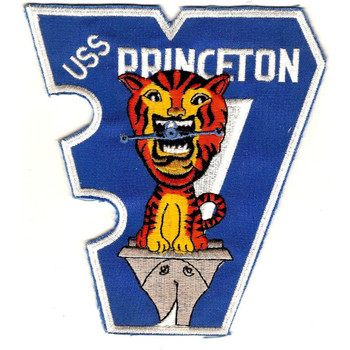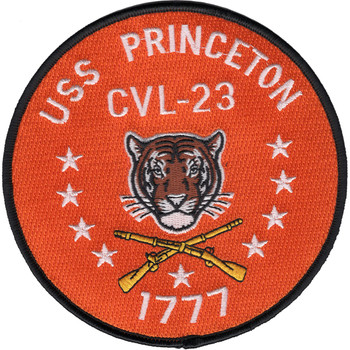Description
SHIPS THE USS PRINCETON CVS-37 "TIGER" (CV-37: dp. 33,000 (f.); 1. 888'; b. 93'; ew. 147'6", dr. 28'7";s. 33 k.; cpl. 3,448, a. 12 5", 44 40mm., 59 20mm., ae. 80+; cl. Essex) CV-37 was laid down as Valley Forge at the Philadelphia Yard 14 September 1943, renamed Princeton 21 November 1944; launched 8 July 1945,sponsored by Mrs. Harold Dodds; and commissioned 18 November 1945, Capt.John M. Hoskins in command. Following shakedown off Cuba, Princeton, with Air Group 81 embarked,remained in the Atlantic and operated with the 8th Fleet until June 1946.Then transferred to the Pacific Fleet, she arrived at San Diego on the 31st,and departed again 3 July to carry the body of Philippine President ManuelQueson back to Luzon for burial. From Manila Princeton joined the 7th Fleetin the Marianas, becoming flagship of TF 77. During September and October she operated in Japanese and Chinese waters, then returned to the Marianaswhere she remained until February 1947. Maneuvers in Hawaiian waters precededher return to San Diego until 15 March. She cruised the west coast, Hawaiianwaters, and the western Pacific (1 October-23 December) during 1948. She then prepared for inactivation and on 20 June decommissioned and joinedother capital ships in the Pacific Reserve Fleet. Reactivated with the outbreak of hostilities in Korea fifteen months later, Princeton recommissioned 28 August 1950. Intensive training refreshedher reservist crew and on 5 December she joined TF 77 off the Korean coast,her planes and pilots (Air Group 19) making possible the reinstitution ofjet combat air patrols over the battle zone. She launched 248 sorties against targets in the Hagaru area to announce her arrival, and for the next sixdays continued the pace to support marines fighting their way down the long,cold road from the Chosin Reservoir to Hungnam. By the 11th, all units had reached the staging area on the coast. Princeton's planes with other Navy,Marine, and squadrons then covered the evacuation from Hungnam through its completion on the 24th. Interdiction missions followed and by 4 April Princeton's planes hadrendered 54 rail and 37 highway bridges inoperable and damaged 44 more.In May they flew against the railroad bridges connecting Pyongyang with Sunehon, Sinanju, Kachon, and the transpeninsula line. Next they combined close air support with raids on power sources in the Hwachon Reservoir areaand with the stabilization of the front there resumed interdiction. Formuch of the summer they pounded supply arteries, concentrating on highways,and in August Princeton got underway for the United States, arriving at San Diego on the 21st. Eight months later, on 30 April 1952, Princeton rejoined TF 77 in thecombat zone. For 138 days her planes flew against the enemy. They sank smallcraft to prevent the recapture of offshore islands; blasted concentrationsof supplies, facilities, and equipment behind enemy lines, participatedin air-gun strikes on coastal cities, pounded the enemy's hydroelectriccomplex at Suiho on the Yalu to turn off power on both sides of that river,destroyed gun positions and supply areas in Pyongyan; and closed mineral processing plants and munitions factories at Sindok, Musan, Aoji, and riaJin. Reclassified CVA-37 (1 October 1952), Princeton returned to California3 November for a two month respite from the western Pacific. In February1953 she was back off the Korean coast and until the end of the conflictlaunched planes for close air support, "Cherokee" strikes againstsupply, artillery, and troop concentrations in enemy territory, and againstroad traffic. She remained in the area after the truce, 27 July, and on7 September got underway for San Diego. In January 1954, Princeton was reclassified CVS-37 and, after conversionat Bremerton, took up antisubmarine/ Hunter-Killer (HUK) training operationsin the eastern Pacific. For the next five years she alternated HUK exercisesoff the west coast with similar operations in the western Pacific and, inlate 1957-early 1958' in the Indian Ocean Persian Gulf area. Reclassifiedagam, 2 March 1959, she emerged from conversion as an amphibious assaultcarrier, LPH-5. Capable of transporting a battalion landing team and carryinghelicopters in place of planes, Princeton's mission became that of verticalenvelopment-the landing of Marines behind enemy beach fortifications andproviding logistics and medical support as they attack from the rear toseize critical points, cut enemy supplies, sever communications, and linkup with assault forces landed on the beaches. From May until January, 1960, Princeton trained with Marine units fromCamp Pendleton, then deployed to WestPac to train in Okinawan waters. Forthe next three years she followed a similar schedule, gaining experiencein her primary mission. Interruptions came m October 1961 when she rescuedsurvivors of merchantmen Pioneer, Mu-e and Sheik grounded on Daito Shimaand in April 1962 when she delivered advisors and helicoptersto Soe Trang in the Mekong Delta area of the Republic of South Viet Nam. In October 1964 Princeton exchanged WestPac training for the real thingas she returned to Viet Nam and joined the Pacific Fleet's Ready Group inoperations against North VietNamese and Viet Cong forces. Combat operations,interrupted in November for flood relief work, continued into the new year,1965, and culminated in May off Chu Lai as she carried out her primary mission, vertical envelopment, for the first time in combat. Returning to her homeport, Long Beach, after that operation, she transportedMarine Air Group 36 to Viet Nam in August, and in February 1966 got underwayfor another tour in the combat zone. Relieving Okinawa as flagship for theAmphibious Ready Group, she engaged the enemy in operations "Jackstay7',26 March- 6 April, to clear the Rung Sat Special Zone of Viet Cong guerrillas,and "Osage", 27 April4 May, to protect Viet-Namese in the PhuLoe area from Viet Cong "harassment". Search and destroy missions against Viet Cong and North Viet-Namese units followed as Princeton provided transportation, medical evacuation,logistics and communication support for the amphibious operation "DeckhouseI", 18-27 June, in the Song Cau district and the Song Cai river valley,then supported 1st Air Cavalry and 101st Airborne units engaged in "NathanHale" to the south of the "Deckhouse I" area. "DeckhouseII" and support for "Hastings" followed as Navy, Marine,and units again combined, this time to impede enemy infiltration from the DMZ. After "Hastings", Princeton sailed for home, arriving 2 September.She deployed again to Viet Nam 30 January-19 June 1967 and again rangedalong that long embattled, highly indented coast. In March she assisted in countering an enemy threat to the Marine artillery base at Cio Ling and evacuated wounded from Con Thien mountain. In April she participated in"Beacon Star", in the Khe Sanh area, and supported search and destroy operations in conjunction with "Shawnee". In May her helicopters lifted Marines to the DMZ to block enemy forces withdrawing across the BenHai river. A much needed overhaul followed Princeton's return to the west coastand in May 1968 she again sailed west to Viet Nam. There as flagship forAmphibious Ready Group Alpha, she provided amphibious assault carrier servicesfor operations "Fortress Attack" III and IV, "Proud Hunter","Swift Pursuit", and "Eager Hunter." In December shereturned to the United States and in April, 1969 she was designated theprime recovery ship for Apollo 10, the lunar mission which paved the wayfor Apollo 11 and the first landing on the moon. Completing that missionsuccessfully, Princeton resumed exercises off the west coast. Princeton received 8 battle stars for service during the Korean Conflict.
View AllClose

















